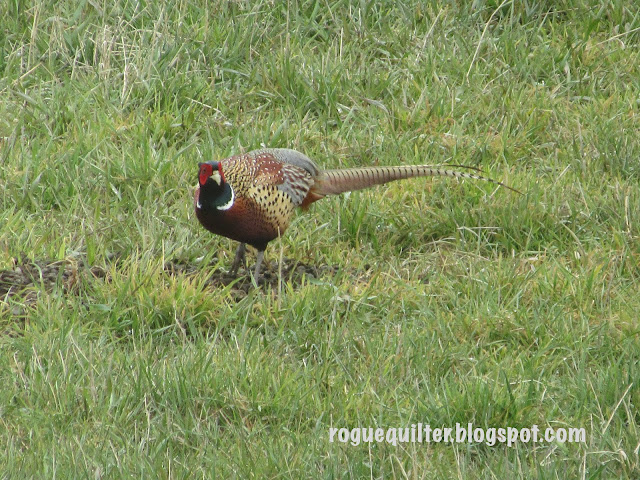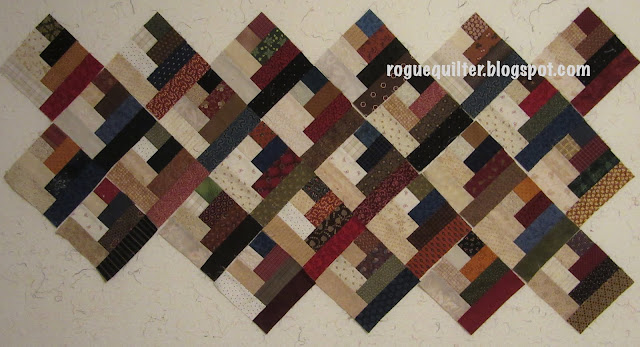I am grateful that I had these logs on hand (sent from Karen @ log cabin quilter blog) so there was something I could sew while the rotary cutter was still off limits. It is exciting to be making good progress on a large quilt, even though I haven't felt like I can do all that much.
I decided to make it 12x14 blocks, and this marks the halfway point.
The other project that has received what little sewing time I have been able to scrounge is "Sophie", from Edyta Sitar's book "Little Handfuls of Scraps". This is my April mini for Wendy's mini-a-month SAL.
This was easy to put together using mini charm squares and leftover strips that I could trim with scissors. Even the binding strips were leftover from another little quilt.

After completing the stitch-in-the-ditch with my walking foot, I really wanted to hand quilt the diagonal lines, and even gave it a try. But I had not used a good scrap of batting for hand needling. After trying to pull the first few stitches through, I could tell it was stressing my shoulder, so I backed off and did it all by machine.
I have been playing with a new-to-me thread, thanks to a blog reader, Joyce L. She introduced me to DMC Machine Embroidery thread, which is recommended for miniature quilt making by mini quilt maker extraordinaire, Sally Collins.
I only knew DMC for its embroidery floss, but was pleased to learn about this thread. It is 50 wt., 100% cotton, and comes in a wide variety of colors. It is very fine--even possibly a hair finer than 50 wt. Aurifil. This means it doesn't add bulk to seams (very important in mini quilts), and it looks more to scale when you machine quilt on mini quilts.
This zoomed-in photo shows it in comparison to the other two threads I use for most of my piecing and quilting.

I have done a lot of piecing with it, and a little bit of machine quilting, along with some binding. It works beautifully for piecing, as mentioned above.
I had no trouble with the little bit of machine quilting I was able to do before my shoulder surgery, but since then I have only been able to quilt with my walking foot. I do like the way it seems to melt into the ditch when doing SITD on little quilts. Heavier thread stands out and looks clunky, but this thread rivals the Aurifil. Since I haven't done a lot of machine quilting with it, I have not been able to gauge how linty it is. Mettler fills the bobbin area of my quilting machine with lint, if I use it for very long. I never have that trouble with Aurifil. It remains to be seen where DMC will fall in that continuum.
The only negative experience I have had has been with binding by hand.
I did quite a bit of the machine quilting on this little quilt using the DMC thread, and it gave me no trouble. But when it came to the hand binding, the end of the thread really frayed as I stitched.
 It surprised me, because I haven't had a cotton thread do this before. It seemed more a "poly" characteristic. But it wasn't a major concern, as the thread never actually broke.
It surprised me, because I haven't had a cotton thread do this before. It seemed more a "poly" characteristic. But it wasn't a major concern, as the thread never actually broke.However, as I did the hand binding on the little "Sophie" quilt, shown earlier in this post, the thread broke not very far into the stitching process, and the ends looked frayed, as above. It isn't a deal breaker for me. This thread is much more reasonably priced than the other two, and it is available in some colors that the other two are not. It is another great tool in my quilting arsenal, and I will just not use it for hand binding anymore.
I will end with a couple of photos my oldest daughter sent us of their recent visit to a tulip farm in Oregon. Wish I could have been there.
Until next time,
Janet O.


























